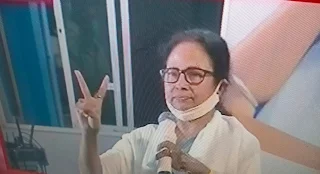The order came the very day of the oath-taking ceremony, no doubt a very subdued affair due to the situation, of Mamata Bannerjee as the new Chief Minister; but, unfortunately, the new order yields precious little in terms of strict curbs or a most-preferred complete lockdown. The order follows largely the same format of the previous order except for the rescheduling of the business hours of the general markets, completely stopping the local train services with immediate effect, reducing the trains of the Metro railway by half, buses to run at half-capacity and ordering all government/private offices at 50% attendance. These measures are far from what is actually desired considering the COVID spread in the state, mostly due to the 8-phase state elections. We will see why.
First, the daily timings of the general markets are from 7 to 10 in the morning and 5 to 7 in the evening other than the essential shops/stores like the chemists and the groceries which are open as usual, and the jewellery shops from 12 noon to 3 pm; but in actual practice, as observed, all essential/non-essential shops manage to remain open throughout or at best are ‘allowed’ the concession of overshooting the closing hours regularly. An average citizen of any age can easily move out of home, travel from end to end of the city, crowd the market freely during the ‘general’ hours or in the ‘essential’ hours or in the ‘jewellery’ hours and can gorge on street food available on the stalls about which the order is not specific or for that matter, about all other vendors selling anything. This defeats the purpose of the stay-home doctrine, so crucial to break the chain of infections.
Second, some of the other measures are contradictory: all offices are to work with 50% attendance, but if local trains are discontinued, metro trains restricted and buses at half-capacity passengers, then how the office-goers are to travel to the workplaces, which means there would be inevitable crowding in the metro trains and in the buses. Not to speak of the commuting needs of the countless businessmen, traders and vendors. Masking norms are mostly being followed in Kolkata and other major cities of the state, but it’s a tough job to enforce the controls in semi-urban and rural areas. Besides, the social distancing norms have been compromised everywhere thanks to the half-hearted measures.
Lastly, although the daily COVID-19 cases have risen slowly from around 17000 to around 19000 in the last few days, we had seen rapid rise from around 1000 cases to over 15000 daily cases during the later election period, and our point is that the slow trend in the last few days cannot be justification for liberal norms, for the dangerous variants of the virus can rise exponentially or even explode anytime like in the states of Maharashtra, Kerala, Karnataka, Uttar Pradesh, Chhattisgarh, Tamil Nadu and Madhya Pradesh. Therefore, it must be said emphatically that the state government is playing with the lives of the people of the state, and waiting for the cases to explode for imposing lockdown is very risky, considering how people have still been dying due to lack of oxygen, lack of medical facilities and over-stressing of the health infra all over the country.
For India as a whole, national lockdown was imposed on 25th March 2020 with hardly a four-hour notice, when the daily infections were just in a few hundreds, concentrated in Maharashtra and Kerala. Well, this is not to contest the decision to lockdown the country, for in the global perspective and the experience of many countries it was deemed necessary. Data analysts were extrapolating at that time that without lockdown the infections and the deaths would have been in hundreds of thousands. This is exactly our point.
While the first pandemic peak in India, reached mid-September 2020, was just above 97000 cases a day and deaths around 1000 a day, the present numbers are more than 4,00,000 daily cases and 4000+ fatalities. The 4-Lakh mark was crossed about ten days back, after which the figures were fluctuating between 3.5 to over 4 Lakh, giving rise to false hopes of the second pandemic peak reached; however, some experts maintain that the peak is expected mid-May or end of May this year. Therefore, it is a valid question to ask: why still no national lockdown? The scenario has been getting bizarre with the states arbitrarily announcing partial or full lockdowns, weekend lockdowns or mini lockdowns whenever they desire, except for the most disciplined state of Maharashtra where the lockdown and anti-COVID strategy has seen the positive results.
In fact, a whole lot of medical experts, scientists and international agencies have been urging India to impose national lockdown since over a fortnight. The Government of India is not listening perhaps for the blues of the earlier lockdowns in terms of economic devastation. We say that the damage done last year is due more to lack of planning and haphazard unlocking than the failure of lockdown as a strategy. No doubt, lockdowns are no solutions, but they can definitely break the chain of infections and save lives by forcing people to stay at home. Further, experts believe that there has been much under-reporting in the numbers of daily infections and deaths, some saying that daily deaths must be around 25000 to create that kind of pressure on the crematoriums, the round-the-clock burning pyres all over the country being witness to the immense human tragedy unfolding. At the moment the most important things to do are to prevent more deaths, de-stress the health sector and ensure regular supply of oxygen; and to achieve that a national lockdown is a must, which, experts maintain, has to be of at least of a two-week duration.








